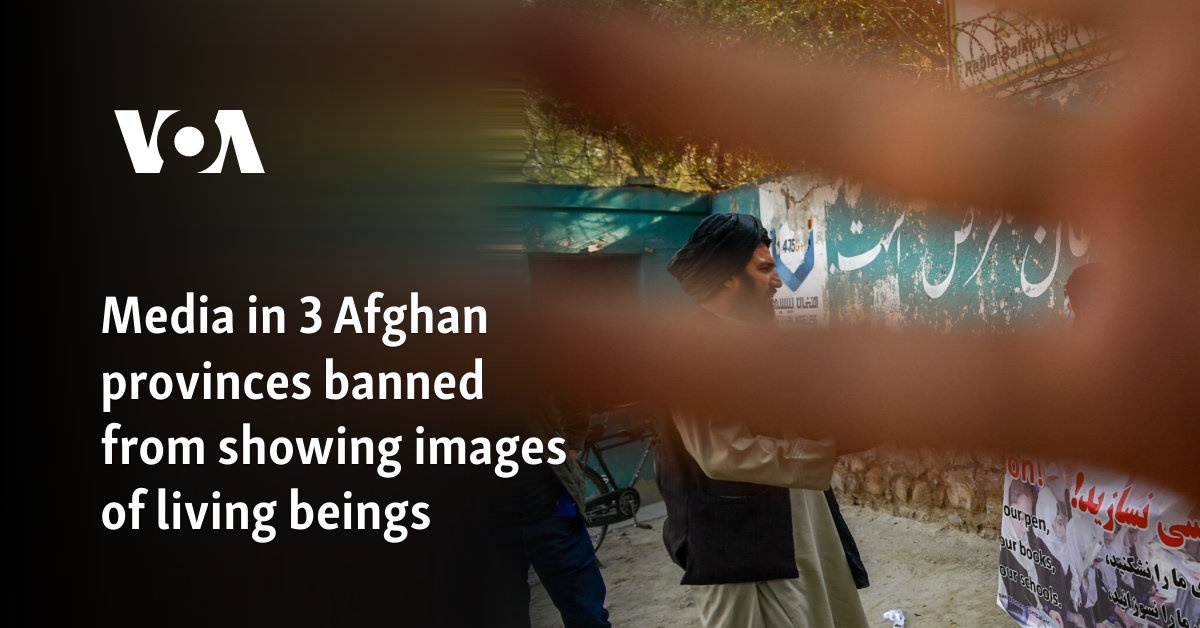The Taliban has ordered media in three provinces of Afghanistan to stop airing images of any living being, a drastic step widely criticized by journalism and civil liberty groups.
A Taliban official said this week that state-run media in the provinces of Takhar, Kandahar, and Maidan Wardak have been told to stop showing images of living things.
Experts who spoke with VOA said the Taliban also met with local media outlets and told them that the rule also applied to their coverage.
The order — part of the new morality law — will be implemented across the country, according to Saiful Islam Khyber, a spokesperson for the Ministry for the Propagation of Virtue and the Prevention of Vice. “The law applies to all Afghanistan,” he told the French news agency AFP.
The spokesperson added that the Taliban will convince people that taking images of living things is against Islamic law.
The ban on images is part of a newly passed law based on the Taliban interpretation of Islam. The law also orders media to not mock Muslims or contradict Islamic law, and further curtails the rights of women.
Officials have not detailed what the penalties will be but under the last Taliban rule, from 1996 to 2001, people could be imprisoned for showing images.
Mohammad Graan, president of the Afghanistan chapter of the South Asian Association of Reporters Club and Journalists Forum, or SJF, told VOA the new instructions are worrying to the media.
Graan added that independent media outlets in Takhar and Maidan Wardak provinces have also been told not to air images of living things.
“Unfortunately, journalists and media outlets are very concerned as it looks like they [Taliban] are implementing the new morality law gradually in provinces,” said Graan.
“It will undoubtedly impact journalists’ work and mental health, as well as create fear among journalists whether they will be able to continue their profession,” he said.
Since the Taliban returned to power in 2021, journalists have worked under increased censorship and restrictions.
Added to the challenges, said Graan, is that journalists and media outlets do not know whether Taliban leaders are all on the same page about the new restrictions.
“The Taliban say that taking pictures or videos is forbidden, but they talk at press conferences in front of TV cameras and appear on TV,” he said.
The United Nations and rights groups expressed concerns over the morality law, with the U.N. calling it a “distressing vision” for Afghanistan, and saying that it imposes severe restrictions on personal freedom and repressing women in the country.
The law gives the Taliban’s morality police “discretionary powers to threaten and detain anyone based on broad and sometimes vague lists of infractions,” said Roza Otunbayeva, the head of the U.N. Assistance Mission in Afghanistan.
The Taliban imposed similar restrictions during their first rule in the late 1990s. At that time, no one was allowed to take pictures, watch television or use the internet.
The Taliban, however, did not impose immediate restrictions on images after they returned to power in August 2021. Officials routinely use video and the internet for their propaganda.
Afghan journalist Ghulam Jilani Zwak told VOA the restrictions are “unprecedented” and that no other Muslim-majority countries have imposed such restrictions.
Most Islamic scholars globally see no issue with showing living beings in photo or video.
“I think because [the Taliban’s government] is an authoritarian regime, it fears freedom of expression and press; therefore, they impose such restrictions on media,” Zwak said.
He said that the Taliban “show no tolerance to dissidents and any criticism of their government.”
Rights watchdogs reported that the human rights situation has deteriorated under the Taliban.
Heather Barr, the women’s rights associate director at Human Rights Watch, told VOA that the Taliban’s order would have a “significant impact” on the coverage of human rights.
How can media outlets “talk about human rights if they are not allowed to depict human beings in their coverage?” said Barr.
She said the law is of concern to women’s rights activists in Afghanistan who use media to make their voices heard.
“Perhaps one of the goals of this new Taliban’s order is to block them from being able to express themselves and to share their experiences with each other through the media and with the world more broadly,” Barr said.
Women in Afghanistan live under repressive measures. They are barred from getting secondary and university education, working with government and non-government organizations, and going to public places, such as parks, gyms, and beauty salons.
Hamid Obaidi, head of the Germany-based Afghanistan Journalists Support Organization, told VOA that banning media from showing living things is the continuation of the Taliban’s “repressive measures against press freedom” in the past three years.
He said that the implementation of the law would mean the closure of all the TV stations in the country.
But, he said, the Taliban’s calculation that it can “beat media into submission” is wrong. He said Afghan journalists and media outlets will continue to function from exile, and technology will help people inside Afghanistan to connect.
“The Taliban think that they can silence Afghan voices, but it is not possible,” he added.
Waheed Faizi and Mohammad Ahmadi contributed to this report.


